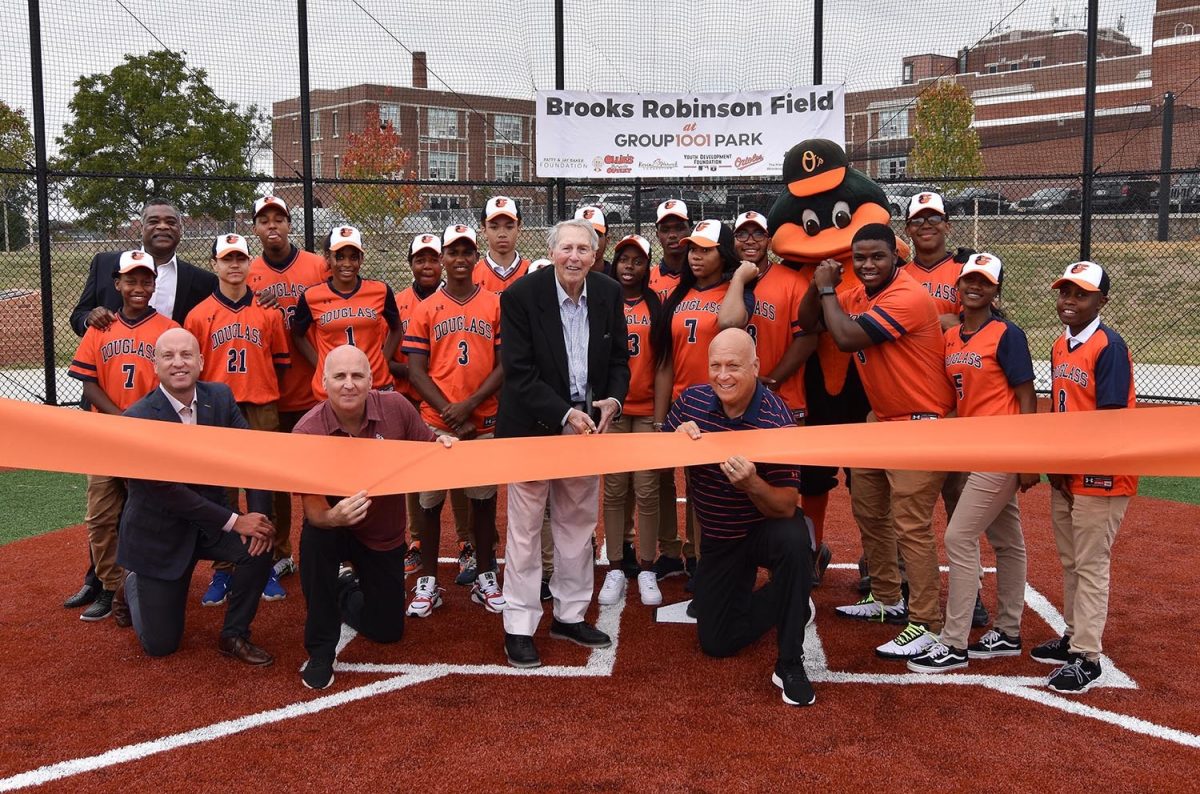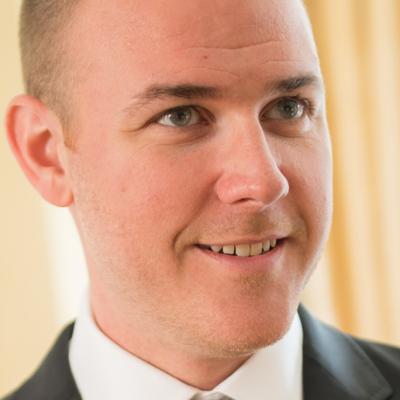
When the beloved Brooks Robinson, now 82 years old—a Baltimore treasure who hears “the greatest third baseman of all-time,” whenever anyone introduces him—arrived at Frederick Douglass High School on Tuesday morning, he saw three students walking outside. The kind soul he is, he figured he’d introduce himself.
“I gain a little humility every day I walk this earth,” Robinson said, starting to recount the story. “I said, ‘Hi, I’m Brooks Robinson.'”
The kids were probably just 70 years younger than him. And curious why the white-haired man wearing a blue blazer, collared shirt, and white pants was heading in the direction of the new baseball field behind the school.
“They’re naming a field after me,” Mr. Robinson said.
“After you?”
“Yeah.”
“Then they just kind of looked at me and headed off,” Robinson said.
So began the welcome for old No. 5—the human vacuum cleaner and autograph signer to all—to the place that will bear his name as long as they’ll play baseball and softball at Frederick Douglass High School. Brooks Robinson Field at Group 1001 Park, a multi-million dollar facility in West Baltimore built by the Cal Ripken Sr. Foundation, is a field worthy of a title sponsor and approval from the Hall-of-Fame headliner himself.
“If this is not the Field of Dreams,” Robinson said, “I don’t know what is.”
In an intimate gathering under a white party tent erected on the field, another one of our local heroes, Cal Ripken Jr., and the foundation he and his brother Billy created in their father’s honor, unveiled the state-of-the-art synthetic turf diamond (the kind that has redish turf in place of real dirt). It’s the third field they’ve built in West Baltimore in recent years, 13th in the city, and 88th nationwide since 2009.
It’s a place for kids to play, sure, instead of “maybe getting into trouble someplace else,” the Ironman said. But the first thing you notice upon arrival is the inspiring scenery—a wonderful view of the downtown skyline in the distance below centerfield. The tops of the city’s tallest buildings peak above the black chainlink home run fence that wraps around the field. Someone with imagination might also see a resemblance to Camden Yards, with the fronts of the brick houses on Windsor Avenue behind right field standing in for the Orioles’ iconic warehouse.
It took a few years and a greater-than-expected $2.5 million, but it’s now a reality—a huge upgrade from the asphalt parking lot that the school’s baseball and softball teams used to take infield practice—and the culmination of an idea the Ripken Foundation hatched in the wake of the riots after Freddie Gray’s death in 2015 to build five fields in West Baltimore. “It just didn’t seem right what was going on,” said Steve Salem, president of the foundation. “The problem is so big and so overwhelming. What could we do?”
They could do what they do. “We want to help kids, and we want to partner with people who want to help kids,” Cal said. “We want them to play, work together, take some responsibility in their lives, and learn how to be a teammate. We know the value of sport. We know the lessons it can teach. By putting a field right here, we give a lot of kids the opportunity to learn them.”
Today’s dedication of the Brooks Robinson Field at Frederick Douglass High School was joined by Cal Ripken Jr., Billy Ripken, Steve Salem, Eddie Murray, and Brooks Robinson!
Softball and baseball season can’t come soon enough. Play ball! ⚾️ pic.twitter.com/yD4QHrlMFd — Baltimore Schools (@BaltCitySchools) September 17, 2019
Since its inception, the Ripken Foundation has partnered with hundreds of youth development programs around the country. Its signature “Badges for Baseball” initiative, created in conjunction with the U.S. Department of Justice, encourages police officers to volunteer as youth sports coaches. The charity evolved into building fields, now in 23 states and Washington, D.C., after “we started to realize with some of our programming is that there wasn’t a safe place for it to happen,” Cal said.
The ribbon-cutting ceremony at Frederick Douglas attracted a cadre of notable guests, like mayor Bernard C. “Jack” Young, city council president Brandon Scott (who announced last week he’ll run for mayor), Hall-of-Famer Eddie Murray (who has a field named after him at James Mosher Elementary School), and private donors and supporters of the project. Among them are Kohl’s department store founder and former Ripken Foundation board chair Jay Baker and former Maryland senator Frank Kelly. It seemed nearly everyone in attendance had a direct or emotional connection to the construction.
“This is about giving people an opportunity,” said Tony Reagins, executive vice president of Major League Baseball, which donated $450,000 the project. “Sometimes all you need as a young person is a chance. This creates it.” Reagins got emotional while reflecting on his first visit to Frederick Douglass a year ago, when he spoke with baseball coach Jim Foster and saw kids practicing on blacktop instead of grass or turf.
The Ripken brothers spoke about the love for their dad, and for Robinson (“Brooks was my hero,” Cal said). Robinson shared his admiration for the former O’s manager before delivering a priceless moment for any baseball fan with a heart. The greatest third baseman of all time started talking about what many, including he, describe as the greatest baseball movie ever, Field of Dreams. He explained how and why the field that now bears his name reminds him of the film.
“I don’t go to movies much, but I saw it twice,” Robinson said. “Both times I had a little tear in my eye right down my cheek. The last part of that movie really got to me, and reminded me so much of my dad.”
He’s, of course, referring to the scene when the character played by Kevin Costner asks his father if he wants to play catch, just before the old-time Yankee heads back into an Iowa cornfield. Robinson’s dad, a semipro baseball player from Arkansas, asked his son the same question regularly. (And we are all thankful.) “My dad was my hero,” Robinson said. “He showed me what baseball is all about—how to act, how to play, give it your best all the time. I think about him all the time. That’s what I’m thinking about when I see that field here.”
As Cal pointed out, any field is only as valuable as those that use it: “When I think about this field, it’s great. The pomp and circumstance is great. But the real value of this field is those relationships that are built and the lessons that are taught on this field. We don’t even know what kind of effect that will have in the future, but we do know it’s going to be a good one.”
A few kids, if they happened to Google Brooks Robinson after meeting him outside their school this week, should have already learned a lesson in humility.
